Papers by Florian Bublatzky
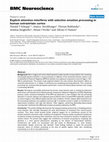
BMC neuroscience, 2007
Brain imaging and event-related potential studies provide strong evidence that emotional stimuli ... more Brain imaging and event-related potential studies provide strong evidence that emotional stimuli guide selective attention in visual processing. A reflection of the emotional attention capture is the increased Early Posterior Negativity (EPN) for pleasant and unpleasant compared to neutral images (approximately 150-300 ms poststimulus). The present study explored whether this early emotion discrimination reflects an automatic phenomenon or is subject to interference by competing processing demands. Thus, emotional processing was assessed while participants performed a concurrent feature-based attention task varying in processing demands. Participants successfully performed the primary visual attention task as revealed by behavioral performance and selected event-related potential components (Selection Negativity and P3b). Replicating previous results, emotional modulation of the EPN was observed in a task condition with low processing demands. In contrast, pleasant and unpleasant pi...

NeuroImage, 2016
The mental representations of space, time, and number magnitude are inherently linked. The right ... more The mental representations of space, time, and number magnitude are inherently linked. The right posterior parietal cortex (PPC) has been suggested to contain a general magnitude system that underlies the overlap between various perceptual dimensions. However, comparative studies including spatial, temporal, and numerical dimensions are missing. In a unified paradigm, we compared the impact of right PPC inhibition on associations with spatial response codes (i.e., Simon, SNARC, and STARC effects) and on congruency effects between space, time, and numbers. Prolonged cortical inhibition was induced by continuous theta-burst stimulation (cTBS), a protocol for transcranial magnetic stimulation (TMS), at the right intraparietal sulcus (IPS). Our results show that congruency effects, but not response code associations, are affected by right PPC inhibition, indicating different neuronal mechanisms underlying these effects. Furthermore, the results demonstrate that interactions between space and time perception are reflected in congruency effects, but not in an association between time and spatial response codes. Taken together, these results implicate that the congruency between purely perceptual dimensions is processed in PPC areas along the IPS, while the congruency between percepts and behavioral responses is independent of this region.

ABSTRACT The present thesis examined the impact of anticipatory anxiety on emotion processing. Fo... more ABSTRACT The present thesis examined the impact of anticipatory anxiety on emotion processing. For this purpose, two well-established research lines were integrated: The "threat-of-shock" and "picture viewing" paradigm. The exposure to pictorial stimuli has been shown to be associated with perceptual, physiological and behavioral changes varying as a function of hedonic picture valence and arousal. Based on an evolutionary perspective, it is assumed that evolved motivational systems mediating approach and avoidance selectively facilitate the perceptual processing of significant information in order to prepare fast and appropriate actions. In favor of dynamic adjustment to phylogenetic and ontogenetic core objectives, these systems easily acquire contingencies of environmental conditions and events. In this context, the threat-of-shock paradigm has been shown to activate the defensive system by means of verbal instructions about aversive environmental contingencies. That is, merely the verbal announcement about imminent danger is sufficient to elicit a defensive state of anticipatory anxiety. Little is known about the impact of aversive anticipation on emotion perception and responding. To investigate this research question two important aspects were pursued: (1) The predictive value of picture materials for threat of aversive events (pictures unrelated or predictive for threat-of-shock) and (2) the focus of processing stage (measurement of perceptual-evaluative processing or motor-behavioral output). Study I examined the impact of sustained threat signals on physiological responses (startle reflex, skin conductance) to pictures which were unrelated to threat-of-shock condition. To this end, pleasant, neutral, and unpleasant pictures were presented as a continuous stream during contextually signaled threat and safety. Previous findings regarding hedonic picture valence and instructed threat were replicated. Of main interest, anticipating aversive events and viewing unrelated affective pictures additively modulated defensive activation. Specifically, despite overall potentiated startle blink magnitude during threat-condition, the startle reflex remained sensitive to hedonic picture valence. In addition, changes in skin conductance level and self-report data support the notion of an enhanced aversive state under instructed threat. Overall, defensive activation by physical threat appeared to operate independently from reflex modulation by unrelated picture media. Study II focused on perceptual processes mutually involved in anticipatory anxiety and affective picture processing. Utilizing an experimental protocol similar to Study I, the main finding was that pleasant pictures mismatching the current aversive context elicited a sustained negative difference potential over visual processing regions. In contrast, unpleasant and neutral picture processing did not vary as a function of threat-of-shock. Furthermore, in both safety and threat conditions, emotional pictures elicited an enlarged early posterior negativity (EPN) and late positive potential (LPP) indicative for preferential emotion processing. These data demonstrated that the activation of the fear/anxiety network exerted valence-specific effects on unrelated picture processing. Complementary to Study I and II, Study III examined the perceptual processing of pictures which were explicitly instructed to cue electric shocks. In different experimental runs, picture categories served as a threat-cue (predictive for threat-of-shock), safe-cue (predictive for no shock), and control cue (no threat-of-shock). Results replicated selective emotion processing as indicated by the EPN and LPP. Furthermore, instructed threat-cues elicited pronounced modulations for the P1, P2 and LPP amplitudes irrespective of the implicit hedonic picture valence. Of main interest, the differentiation between threat, safe and control cues varied across the visual processing stream. Depending on the predictive picture value and elapsed processing time, stimulus processing progressively gained high-accuracy information about environmental conditions. Integrating both threat-of-shock and picture viewing paradigm the present thesis demonstrated the mutual impact of aversive anticipation and emotion processing. At the level of perceptual-evaluative processes, motor-behavioral output and self-report data, key findings regarding both manipulations were fully replicated. Of main interest, threat-of-shock revealed valence-specific and valence-unspecific effects on picture processing. These findings depend critically on whether the picture content is predictive or unrelated to threat-of-shock, and which processing stage is focused (perceptual-evaluative, behavioral/motor output). Overall, the anticipation of real-world aversive events dynamically modulated the information processing stream and psychophysiological response systems in order to flexibly adjust the organism…
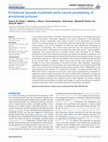
Frontiers in Psychology, 2013
In our natural environment, emotional information is conveyed by converging visual and auditory i... more In our natural environment, emotional information is conveyed by converging visual and auditory information; multimodal integration is of utmost importance. In the laboratory, however, emotion researchers have mostly focused on the examination of unimodal stimuli. Few existing studies on multimodal emotion processing have focused on human communication such as the integration of facial and vocal expressions. Extending the concept of multimodality, the current study examines how the neural processing of emotional pictures is influenced by simultaneously presented sounds. Twenty pleasant, unpleasant, and neutral pictures of complex scenes were presented to 22 healthy participants. On the critical trials these pictures were paired with pleasant, unpleasant, and neutral sounds. Sound presentation started 500 ms before picture onset and each stimulus presentation lasted for 2 s. EEG was recorded from 64 channels and ERP analyses focused on the picture onset. In addition, valence and arousal ratings were obtained. Previous findings for the neural processing of emotional pictures were replicated. Specifically, unpleasant compared to neutral pictures were associated with an increased parietal P200 and a more pronounced centroparietal late positive potential (LPP), independent of the accompanying sound valence. For audiovisual stimulation, increased parietal P100 and P200 were found in response to all pictures which were accompanied by unpleasant or pleasant sounds compared to pictures with neutral sounds. Most importantly, incongruent audiovisual pairs of unpleasant pictures and pleasant sounds enhanced parietal P100 and P200 compared to pairings with congruent sounds. Taken together, the present findings indicate that emotional sounds modulate early stages of visual processing and, therefore, provide an avenue by which multimodal experience may enhance perception.

Biological Psychology, 2015
A strong link between body perception and emotional experience has been proposed. To examine the ... more A strong link between body perception and emotional experience has been proposed. To examine the interaction between body perception and anticipatory anxiety, two well-established paradigms were combined: The rubber hand illusion (RHI) and the threat-of-shock paradigm. An artificial hand and the participants' own hand (hidden from sight) were touched synchronously or asynchronously, while either threat-of-shock or safety was cued. Potentiated startle reflexes and enhanced skin conductance responses were observed during threat as compared to safety conditions, but threat conditions did not interact with illusory body perceptions. Thus, defense system activation was not modulated by altered body representations. Physiological responses increased with the sense of ownership for the artificial limb, but not with proprioceptive drift towards its location. The results indicate that ownership ratings and proprioceptive drift capture different aspects of the RHI. The study presents a new approach to investigate the relationship between body representations and emotional states.
Zeitschrift für Psychiatrie, Psychologie und Psychotherapie, 2014
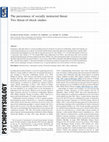
Psychophysiology, 2014
Learning to anticipate threat is crucial in guiding protective behavior. In classical conditionin... more Learning to anticipate threat is crucial in guiding protective behavior. In classical conditioning, single trial learning can result in long-lasting fear associations. To examine whether threat learned through social communication is equally stable, an instructed fear paradigm was used with two repeated sessions on 1 day (Study 1; N = 43) and with separate sessions on 3 consecutive days (Study 2; N = 30). Startle EMG, skin conductance level (SCL), and self-report data were recorded during alternating periods of instructed threat and safety. Within 1 day, threat-potentiated startle was present across sessions but threat-enhanced SCL decreased (Study 1). Across days, threat effects subsided with different timing for startle EMG, SCL, and self-report (Study 2). The present findings are a laboratory analog for the persistence of socially transmitted fear, which can be amazingly resistant to extinction (e.g., in specific phobias) even in the absence of aversive experiences.
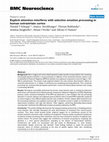
BMC neuroscience, 2007
Brain imaging and event-related potential studies provide strong evidence that emotional stimuli ... more Brain imaging and event-related potential studies provide strong evidence that emotional stimuli guide selective attention in visual processing. A reflection of the emotional attention capture is the increased Early Posterior Negativity (EPN) for pleasant and unpleasant compared to neutral images (approximately 150-300 ms poststimulus). The present study explored whether this early emotion discrimination reflects an automatic phenomenon or is subject to interference by competing processing demands. Thus, emotional processing was assessed while participants performed a concurrent feature-based attention task varying in processing demands. Participants successfully performed the primary visual attention task as revealed by behavioral performance and selected event-related potential components (Selection Negativity and P3b). Replicating previous results, emotional modulation of the EPN was observed in a task condition with low processing demands. In contrast, pleasant and unpleasant pi...
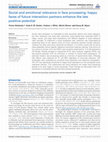
Frontiers in human neuroscience, 2014
Human face perception is modulated by both emotional valence and social relevance, but their inte... more Human face perception is modulated by both emotional valence and social relevance, but their interaction has rarely been examined. Event-related brain potentials (ERP) to happy, neutral, and angry facial expressions with different degrees of social relevance were recorded. To implement a social anticipation task, relevance was manipulated by presenting faces of two specific actors as future interaction partners (socially relevant), whereas two other face actors remained non-relevant. In a further control task all stimuli were presented without specific relevance instructions (passive viewing). Face stimuli of four actors (2 women, from the KDEF) were randomly presented for 1s to 26 participants (16 female). Results showed an augmented N170, early posterior negativity (EPN), and late positive potential (LPP) for emotional in contrast to neutral facial expressions. Of particular interest, face processing varied as a function of experimental tasks. Whereas task effects were observed fo...

Acta Psychologica, 2014
The rubber hand illusion (RHI), in which a visible artificial hand is touched (or moves) synchron... more The rubber hand illusion (RHI), in which a visible artificial hand is touched (or moves) synchronously with the participant's unseen own hand, indicates that body representations can undergo rapid changes. While several constraints for this illusion have been described, some reports highlight a remarkable flexibility of body representations, even contradicting a priori assumptions regarding body appearance and anatomy (e.g., the subjective embodiment of a third arm). Here we examine the impact of congruence between touches at (or movements of) the real and the artificial hand, as well as the role of predictability of touches (or movements). We implemented two versions of the RHI paradigm, based on passive tactile stimulation and active voluntary movements. The results show that (a) predictability does not modulate perceived embodiment, and that (b) congruent mapping between real and artificial fingers is a necessary condition for both the tactile and the motor RHI. Together with previously reported constraints for bodily illusions, these results are reduced to four principles, which determine subjective embodiment: temporal synchrony, congruence of mapping between real and artificial body parts, body unity and body shape.
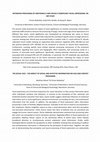
The present study examined the impact of social significance on emotion processing. Event-related... more The present study examined the impact of social significance on emotion processing. Event-related potentials (ERP) served to measure the processing of happy, neutral and angry facial expressions of 4 different face actors. Social significance was manipulated by introducing two actors as future interaction partners. Further control tasks required the counting of specific actors as target stimuli or a passive viewing task. Stimuli were presented briefly in random order (1 s each) without ITI. Results replicated recent studies showing an augmented early posterior negativity (EPN, 200-300 ms) and late positive potential (LPP, 400-600 ms) for emotional in contrast to neutral facial expressions. Furthermore, counting specific faces elicited selective processing reminiscent of the emotional modulation regarding time course and topography. More important, face processing varied as a function of instructed social significance. Specifically, viewing potential interaction partners was associated with increased EPN and LPP amplitudes. In particular, the LPP amplitude was specifically enhanced for emotional faces of the future interaction partners. Indicating the impact of social significance, the mere verbal instruction about future interaction modulated face processing already at an early level of visual processing.











Uploads
Papers by Florian Bublatzky